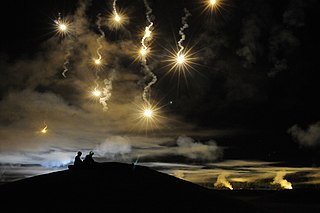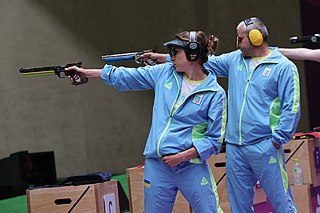
A flare, also sometimes called a fusée, fusee, or bengala, bengalo in several European countries, is a type of pyrotechnic that produces a bright light or intense heat without an explosion. Flares are used for distress signaling, illumination, or defensive countermeasures in civilian and military applications. Flares may be ground pyrotechnics, projectile pyrotechnics, or parachute-suspended to provide maximum illumination time over a large area. Projectile pyrotechnics may be dropped from aircraft, fired from rocket or artillery, or deployed by flare guns or handheld percussive tubes.

An air gun or airgun is a gun that uses energy from compressed air or other gases that are mechanically pressurized and then released to propel and accelerate projectiles, similar to the principle of the primitive blowgun. This is in contrast to a firearm, which shoots projectiles using energy generated via exothermic combustion (detonation) of chemical propellants, most often black powder or smokeless powder.

Pyrotechnics is the science and craft of creating such things as fireworks, safety matches, oxygen candles, explosive bolts and other fasteners, parts of automotive airbags, as well as gas-pressure blasting in mining, quarrying, and demolition. This trade relies upon self-contained and self-sustained exothermic chemical reactions to make heat, light, gas, smoke and/or sound. The name comes from the Greek words pyr ("fire") and tekhnikos.

A semi-automatic pistol is a repeating handgun that automatically ejects and loads cartridges in its chamber after every shot fired, but only one round of ammunition is fired each time the trigger is pulled. The pistol's fire control group disconnects the trigger mechanism from the firing pin/striker until the trigger has been released and reset manually, unlike the self-cycled firing mechanism in fully automatic pistols.

The .45 ACP, also known as .45 Auto, .45 Automatic, or 11.43×23mm is a rimless straight-walled handgun cartridge designed by John Moses Browning in 1904, for use in his prototype Colt semi-automatic pistol. After successful military trials, it was adopted as the standard chambering for Colt's M1911 pistol. The round was developed due to a lack of stopping power experienced in the Moro Rebellion in places like Sulu. The issued ammunition, .38 Long Colt, had proved inadequate, motivating the search for a better cartridge. This experience and the Thompson–LaGarde Tests of 1904 led the Army and the Cavalry to decide that a minimum of .45 caliber was required in a new handgun cartridge.

The .357 SIG is a bottlenecked rimless centerfire handgun cartridge developed by the Swiss-German firearms manufacturer SIG Sauer, in cooperation with ammunition manufacturer Federal Premium. The cartridge is used by a number of law enforcement agencies.

The Walther P99 is a semi-automatic pistol developed by the German company Carl Walther GmbH Sportwaffen of Ulm for law enforcement, security forces and the civilian shooting market as a replacement for the Walther P5 and the P88. The P99 and its variants are also made under licence by Fabryka Broni Radom.

The Desert Eagle or "Deagle" is a single-action, gas-operated, semi-automatic pistol capable of chambering the .50 Action Express, the largest centerfire cartridge of any magazine-fed, self-loading pistol and famous for other large caliber chamberings.

The Gyrojet is a family of unique firearms developed in the 1960s named for the method of gyroscopically stabilizing its projectiles. Rather than inert bullets, Gyrojets fire small rockets called Microjets which have little recoil and do not require a heavy barrel or chamber to resist the pressure of the combustion gases. Velocity on leaving the tube was very low, but increased to around 1,250 feet per second (380 m/s) at 30 feet (9.1 m). The result is a very lightweight and transportable weapon.

The .410 bore (10.4 mm) is one of the smallest caliber of shotgun shell commonly available. A .410 bore shotgun loaded with shot shells is well suited for small game hunting and pest control. The .410 started off in the United Kingdom as a garden gun along with the .360 and the No. 3 bore (9 mm) rimfire, No. 2 bore (7 mm) rimfire, and No. 1 bore (6 mm) rimfire. .410 shells have similar base dimensions to the .45 Colt cartridge, allowing many single-shot firearms, as well as derringers and revolvers chambered in that caliber, to fire .410 shot shells without any modifications.

A flare gun, also known as a Very pistol or signal pistol, is a large-bore handgun that discharges flares, blanks and smoke. The flare gun is typically used to produce a distress signal.

The 10 metre air pistol is an Olympic shooting event governed by the International Shooting Sport Federation (ISSF). It is similar to 10 metre air rifle in that it is shot with 4.5 mm caliber air guns at a distance of 10 metres, and that the match consists of a qualification round of 60 competition shots within 75 minutes. If an electronic scoring system (EST) is not available, 15 minutes are added to the time limit. Competitors are allowed to shoot an unlimited number of shots during the 15 minutes preparation and sighting time. Along with the 50 meter pistol, it is considered a precision shooting event. Thus, numerous shooters compete in both events.

The United States Armed Forces has created a plethora of different types of 40 mm grenades in both the low-velocity 40×46 mm and high-velocity 40×53 mm calibers which uses what it calls a high-low propulsion system which keeps recoil forces within the boundaries of an infantry weapon. Presented on this page is a basic overview.

The Remington XP-100 is a bolt-action pistol produced by Remington Arms from 1963 to 1998. The XP-100 was one of the first handguns designed for long-range shooting and introduced the .221 Fireball and 6×45mm. The XP-100 was noted for its accuracy and is still viewed as competitive today in the sport of handgun varminting, which it helped create, as well as in metallic silhouette shooting.

The Beretta 90-Two is a series of semi-automatic pistols designed and manufactured by Beretta of Italy. It was released in 2006 as an enhanced version of the Beretta 92, and is produced in 9×19mm, 9×21mm IMI and .40 S&W versions.

The Benelli Kite is a single shot .177 inch calibre pre-charged pneumatic air pistol designed for the 10 m Air Pistol ISSF shooting event. It is manufactured by Benelli Armi SpA of Italy.

The PB-4 Osa, is a family of Russian non-lethal pistols that can be also used as a flare gun, a flashbang gun, or a starting pistol. The system consists of the pistol, and various ammunition types.
Chiappa Firearms, Armi Sport di Chiappa, is an Italian firearms manufacturing company based in Brescia. It was founded in 1958 by Ezechiele Chiappa as Armi Sport. Total unit production is around 60,000 per year. Its U.S. headquarters are in Dayton, Ohio.

The Ruger AR-556 is a semiautomatic AR-15 style rifle manufactured by U.S. firearms company Sturm, Ruger & Co. Introduced in 2014 as an entry-level AR-15 using a direct impingement action, with variants since being released such as the upgraded AR-556 MPR in 2017 and the AR-556 pistol in 2019.


















